How to care for cabbage in open ground
All varieties and varieties of cabbage love sun and moisture, but these two conditions are not enough to get a good harvest. Plants must be planted on time, properly fertilized, loosened and hilled, and treated against pests and diseases. We will talk about the general rules for growing crops and caring for them in open ground, as well as the differences in agricultural technology for different varieties.
Secrets of growing cabbage in the garden
Plant productivity largely depends on the correct choice of variety. Frost-resistant cabbage is suitable for cold areas. In regions with a dry climate, attention is paid to adaptation to heat, drought and bolting. In conditions of high humidity, varieties that are resistant to diseases and cracking of heads of cabbage are selected.
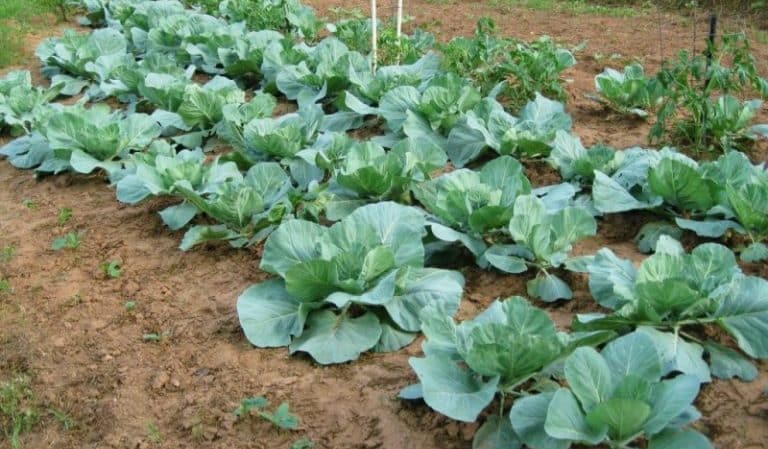
How to grow good cabbage depending on the timing of its ripening:
- Early varieties are not suitable for storage. They have small, loose forks and low yields. Vegetables are good in salads and after heat treatment.
- Mid-season varieties have higher yields, but a short shelf life. Heads of cabbage are suitable for salads, pickling, pickling and canning.
- Late cabbage produces large yields of large heads of cabbage. These varieties are stored or processed for a long time.
Cabbage is planted only in sunny areas - in the shade the leaves stretch out and the forks do not tie. Early and mid-ripening varieties grow well on sandy loam and light loamy soil, late ones - on sod-podzolic soil with a neutral pH. Liming will help reduce acidity and improve the taste of vegetables.
Favorable predecessors:
- cucumber;
- potato;
- onion;
- garlic.

You cannot plant cabbage after cruciferous vegetables. The culture is returned to its original place after 3 years.
Cabbage loves organics. The beds are prepared in the fall: fertilized with fresh manure (5 kg/m2) or compost (6–8 kg/m2) and dig to the depth of a bayonet. In the spring, they deeply loosen and add a complex of mineral fertilizers.
Advice! To increase the yield, add “Mag-Bor” (1 tbsp per 1 m2).
Features of fertilizing:
- early varieties - more nitrogen and moderate phosphorus-potassium nutrition;
- mid-season — emphasis on nitrogen-potassium mixtures;
- late - moderate amount of nitrogen with increased nutrition of potassium and phosphorus.
Early and mid-season varieties are fed 2-3 times per season, late varieties - 3-4 times.
How to care for cabbage in open ground
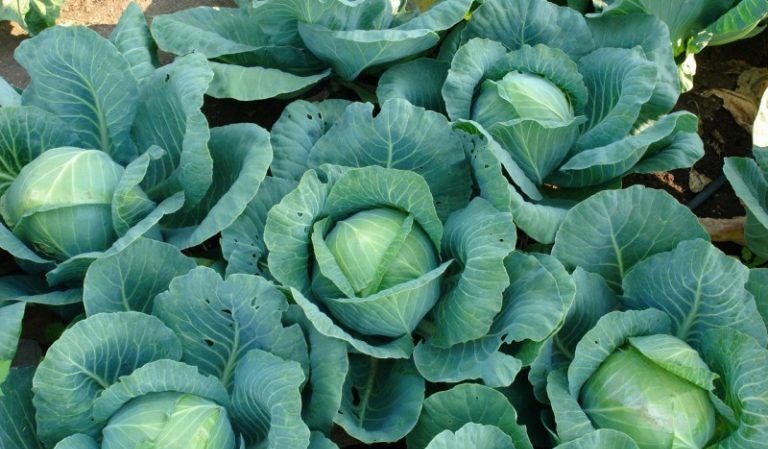
The timing of transferring seedlings to open ground depends on the variety and varietal characteristics of cabbage.
General guidelines:
- steady air temperature - +10...+15°С;
- seedlings in the phase of 5-6 true leaves.
Plants are transplanted using the transshipment method, into holes the size of an earthen clod. Small watering holes are formed around.
Reference! To protect against mole crickets, the first watering is carried out with a tar solution (1 tablespoon per bucket of water) so that the liquid does not get on the plants.
From the moment cabbage is planted in open ground, pest prevention begins. The beds are dusted with wood ash or tobacco dust. Marigolds and spring garlic are planted nearby. Once a week, sprinkling is carried out with the addition of fir oil (10–13 drops per bucket of water).
Frequent and abundant watering causes the soil to become compacted and a crust to form on the surface. To prevent this from happening, the root zone and row spacing are loosened to improve soil aeration.To stimulate the growth of lateral roots, cabbage is hilled 1-2 times. Loosening begins a week after planting, hilling - after 2 weeks. Continue until the leaves close.
Watering cabbage
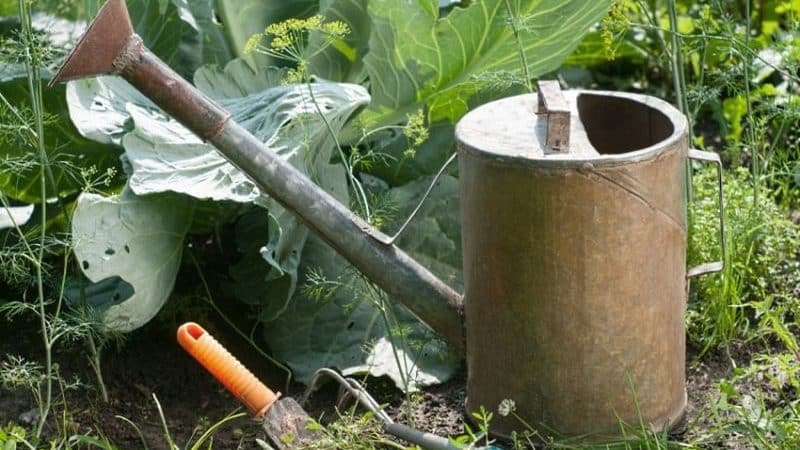
The optimal soil moisture for the crop is about 80%. Water the plants in the morning or evening with warm water heated by the sun. In the first half of the growing season - every 3-4 days, from the second half - once a week, spending 2-4 liters per young plant and 10-15 liters per adult. In hot weather, the crop is moistened as the soil dries and watering is stopped 3 weeks before harvest. Root watering is alternated with sprinkling.
Alternative methods:
- Drip irrigation — water is supplied constantly, in small portions, through holes in pipes or hoses.
- Subsoil irrigation - convenient for small beds. Plastic bottles with holes are dug into the ground between the plants and filled with water, which is dosed to the roots.
At what temperature does cabbage grow?
The optimal temperature for seedlings in open ground is +12…+22°C. Ideal conditions for adult cabbage are +16...+25°C. With prolonged heat above +30°C, the development of the crop stops.
Weeding
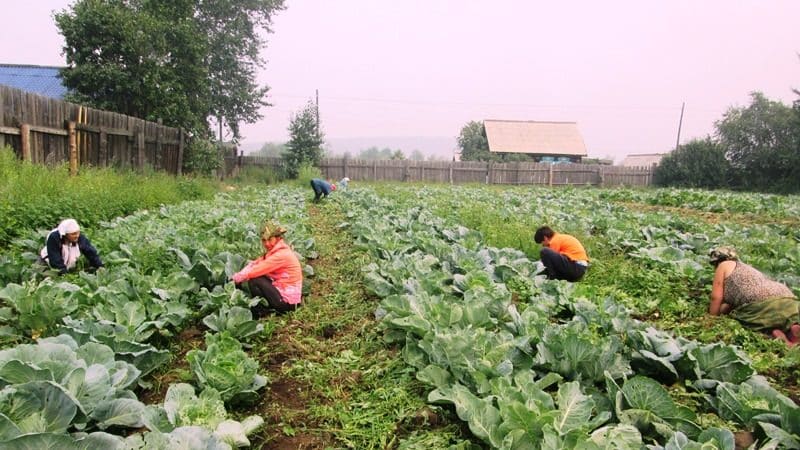
Weeds not only deplete the soil, but also spread insect pests. The beds are weeded systematically, after each watering. When fighting weeds, it is not advisable to use chemicals so that cabbage does not accumulate harmful substances. The best way is to mulch the soil with organic matter or pine needles, which will additionally protect the plantings from slugs.
Caring for cabbage in August
In August, late varieties form heads of cabbage, while mid-season varieties are already gaining weight. At this time, reduce the dose of nitrogen fertilizers and switch the cabbage to increased nutrition with phosphorus, potassium, calcium and magnesium.
Feeding options:
- nitrophoska, superphosphate, potassium sulfate (1 tbsp.) mix and add 1 m to moist, loose soil between rows2;
- additional foliar feeding - 15 g of magnesium sulfate is dissolved in 10 liters of water, used for 10 m2;
- ash fertilizer by the end of August - 2 tbsp. ash is steamed for 6 hours in 1 liter of boiling water and diluted in 10 liters of water, add 2 liters per m2.
Large leaves make it difficult for water to access, so it is more effective to water the plants at the root. In hot weather, the frequency of watering is increased to 1 time every 2-3 days.
Technology of growing and cultivating white cabbage
The seedless growing method is suitable for southern latitudes. Cabbage is sown in open ground from mid-March to the end of April. Before sowing, the soil is heated for a week under plastic film.
Advice! It is more effective to grow cabbage in one row in a long bed, which is located from north to south.
Using the bottom of a glass bottle, press holes 2–4 cm deep, in increments of 50–60 cm for early and mid-season varieties and 70 cm for late varieties. Place 3-4 seeds in each. The seeds are dusted with wood ash, sprinkled with humus and watered. The well is covered with a cap made of a plastic bottle with a cut bottom. Weak shoots are pinched. When the seedlings become crowded, the shelter is removed.
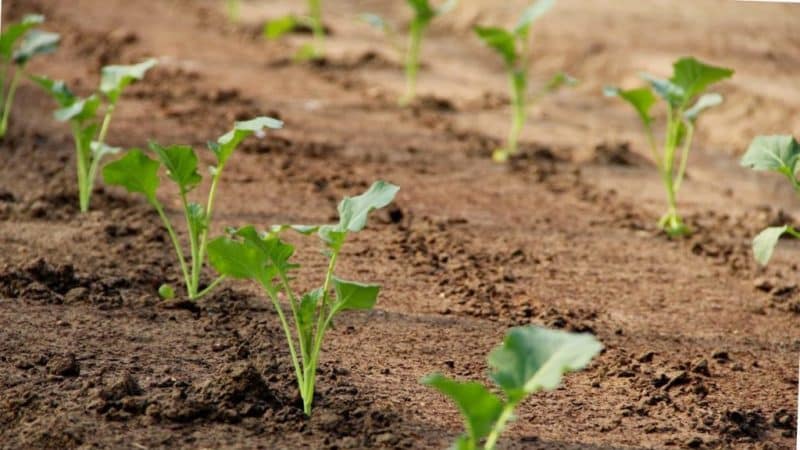
The timing of sowing seeds for seedlings depends on the time of cabbage ripening:
- early varieties - from March 10 to March 25;
- mid-season - from March 25 to April 25;
- late - from April 5 to April 20.
Sow the crop in trays or cassettes. Use ready-made universal soil for seedlings. The sowing pattern is 2x2 cm with a depth of 0.5 cm.
Temperature:
- until germination - +18...+22°С;
- after germination - +15...+17°C during the day and up to +8...+10°C at night.
Water so as to maintain constant moderate soil moisture.Seedlings are picked in the phase of 2 true leaves. 9 days after picking, feed (2 g ammonium nitrate, 2 g potassium fertilizer, 4 g superphosphate per 1 liter of water).
They are transferred to open ground in the phase of 6 true leaves:
- early - from late April to early May, planted in increments of 50x50 cm;
- mid-season - from the end of May to mid-June, according to the 60x70 cm pattern;
- late - from mid to late May, planting pattern - 70x80 cm.
Feeding calendar;
- first - 20 days after planting (10 g of urea per bucket of water, 1 tbsp per plant);
- second and third - during the formation of heads of cabbage (20 g of potassium monophosphate per bucket of water, 1 tbsp. for each plant).
The crop is hilled 2-3 times per season. Mulching the soil eliminates the need for loosening and weeding of cabbage and prevents moisture evaporation.
Picking white cabbage seedlings
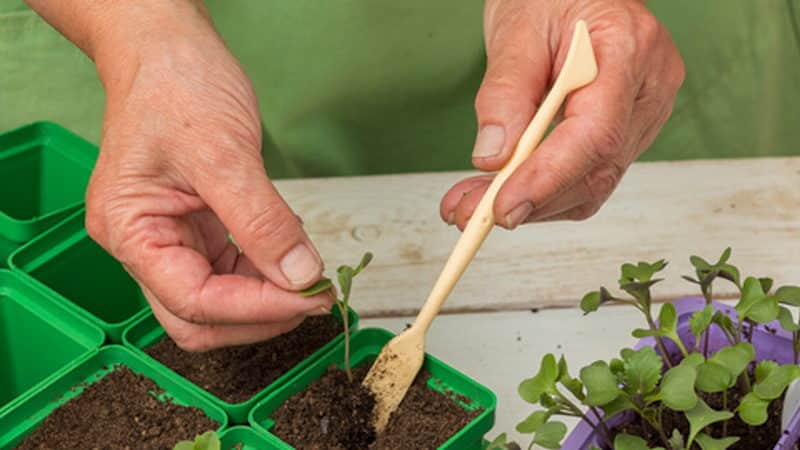
The classic variant of picking is an intermediate transplant with pinching off 1/3 of the central root. As a result, the cabbage develops a powerful network of lateral roots, ties its forks more actively, sits stably in the ground and does not fall to one side.
Methods of modern organic farming exclude pinching. The task of the central root is to extract water from the deep layers of the soil. After pinching it does not recover. Plants lose drought resistance and require frequent feeding and watering. Such conditions are difficult to provide for summer residents who come to the garden once a week.
Picking goals:
- natural selection - during transplantation only strong shoots are left;
- disease prevention - changing the soil reduces the risk of root disease;
- stress resistance - seedlings with experience in adapting to new conditions will quickly take root in open ground;
- vitality - picking with stem deepening stimulates the growth of lateral roots.
When to dive
Seedlings are picked in the phase of 2 true leaves. Approximate dates:
- early and mid-ripening varieties - 7-8 days after germination;
- late - 9-10 days from germination.
Cabbage is replanted no later than 14–16 days from the moment of germination, otherwise the roots will intertwine with each other and the seedlings will be more difficult to separate without damage. The effectiveness of picking will decrease due to the long recovery period of plants.
How to dive
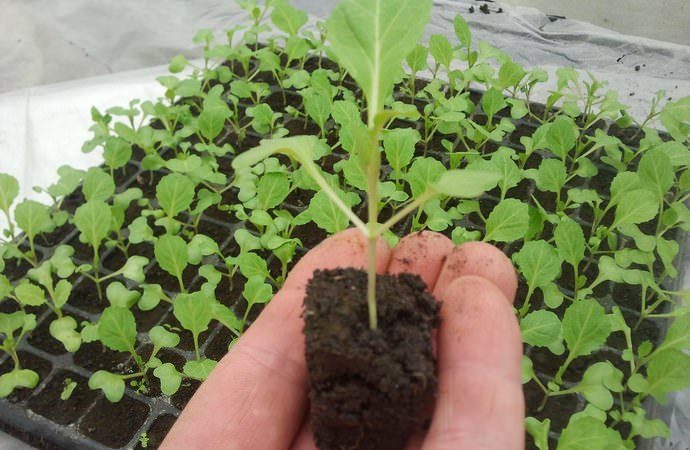
Seedlings are distributed into separate pots or planted in groups in large containers. Holes are pierced in the containers to allow water to drain.
The volume of the container (earth ball) depends on the cabbage variety:
- for early and mid-season - 0.2-0.3 l;
- for mid-late and late varieties - 0.3–0.5 l.
The soil is the same as for sowing seeds: light and loose, with neutral acidity (6.5–7 pH). A mixture of peat, compost and river sand (3:5:1) or ready-made soil for seedlings is suitable.
Reference! Seedlings are watered the day before transplanting - it will be easier to remove them from moderately moist and pliable soil.
Work order:
- The pots are filled with soil 1-2 cm below the edges. A hole is made in the center with a depth of 5–7 cm and a diameter of up to 2 cm. If seedlings are transplanted from cassettes using the transshipment method, the size of the hole should be 1 cm wider than the earthen ball. The holes in the containers are arranged in a checkerboard pattern according to the 8x8 cm pattern.
- The seedling is held by the leaves and pulled out of the ground with a spatula or a teaspoon. If desired, pinch 1/3 of the central root (it is the longest).
- The plant is planted in the hole up to the cotyledon leaves. The soil is compacted and watered abundantly with water at room temperature.
- The harvested seedlings are kept in partial shade for 3 days, at a temperature of +18...+20°C. Then they return to the usual regime: sun, long daylight hours, +14...+16°C during the day and +10...+12°C at night.
Agricultural technology of late cabbage

Features of late varieties of cabbage:
- growing season - from 120 to 150 days;
- large heads of cabbage and high yield;
- keeping quality - up to 6-7 months;
- does not accumulate nitrates;
- in short summer conditions, they are grown only through seedlings.
Seedlings are sown in April. They are transferred to the garden bed at a stable temperature of +12…+15°C. Seedlings of late varieties are not cold-resistant, so they are hardened off in the fresh air 2 weeks before planting.
Sowing in open ground is carried out only in well-warmed soil. The seeding depth is 2-3 cm. Plants are thinned out in the phase of 2-3 true leaves. During cold weather, the beds are covered with film.
The planting pattern is sparse. Cabbage stays in the garden for a long time, its rosettes are large, so it requires a lot of light to fully ripen. If you thicken it, the leaves will grow, but the forks will not tie.
Fertilizers are applied:
- in the 5-leaf phase;
- when a rosette is formed;
- at the stage of head formation;
- during the period of fork mass gain.
The harvest is harvested in the phase of biological ripeness. It is advisable to do this before the first frost, but the forks are not afraid of a slight frost - you just need to wait until they thaw in the daytime.
Conclusion
Without sun and watering, cabbage will not tie a fork. Fertilizers are required so that a rosette quickly forms and the heads of cabbage gain maximum weight. The composition of the soil affects the taste of vegetables and the crop's resistance to disease. Under optimal development conditions and proper care, any variety will show high productivity.